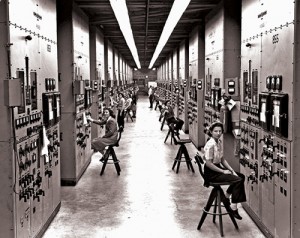
Author Denise Kiernan signs copies of “The Girls of Atomic City” after a lecture at the American Museum of Science and Energy. (Photo by D. Ray Smith)
A book project that started with a famous photo of women enriching uranium at the Y-12 National Security Complex during World War II has ended up on the New York Times best seller list.
ItŌĆÖs also led to appearances on major television shows for Denise Kiernan, author of ŌĆ£The Girls of Atomic CityŌĆöThe Untold Story of the Women Who Helped Win World War II.ŌĆØ SheŌĆÖs recently been a guest on ŌĆ£The Daily Show with Jon Stewart,ŌĆØ ŌĆ£Morning JoeŌĆØ on MSNBC, and PBS NewsHour.
Released March 5, ŌĆ£The Girls of Atomic CityŌĆØ remained at No. 33 on the hard cover nonfiction list on Sunday night.
ŌĆ£IŌĆÖve been thrilled with the response,ŌĆØ Kiernan said during a recent lecture and book-signing at the American Museum of Science and Energy in Oak Ridge. ŌĆ£The country is just fascinated with your town and your stories.ŌĆØ
The book has been reviewed by┬ĀUSA Today┬Āand┬ĀThe Daily Beast.
Kiernan said she was inspired by a photo by Ed Westcott, the governmentŌĆÖs official photographer in Oak Ridge during the war. The picture shows young women, many of them high school graduates from rural Tennessee, working at Y-12 calutrons, which were used to enrich uranium for the first atomic bomb as part of the top-secret Manhattan Project. Due to the secrecy, the women didnŌĆÖt know what they were working on.

Author Denise Kiernan says this photo inspired her to write a book on women in Oak Ridge during World War II. The photo by Ed Westcott shows women enriching uranium at calutrons at the Y-12 National Security Complex as part of the top-secret Manhattan Project.
But Oak Ridge workersŌĆöand the worldŌĆölearned more about the work in Oak Ridge on Aug. 6, 1945, when the first atomic bomb used in combatŌĆöcode-named ŌĆ£Little BoyŌĆØŌĆöwas detonated over Hiroshima, Japan, shortly before the end of World War II. Oak Ridge was mentioned in the┬Āaddress given by President Harry S. Truman┬Āafter the bomb was dropped.
Kiernan said Los Alamos is the Manhattan Project town most often associated with the development of the bomb.
But Oak Ridge was the largest, and it was the administrative headquarters. The ŌĆ£Secret CityŌĆØ was not shown on maps, but it had one of the 10 largest bus systems in the country. It grew to 75,000 people during the war, and plants ran 24 hours per day. Most of the Oak Ridge employees were women, and they worked in fields ranging from administration to transportation to communications.
ŌĆ£There were just tens of thousands of people who played such an incredible role in this project, and I wanted to hear what they had to say,ŌĆØ Kiernan said.
In interviews, Oak Ridge workers, both men and women, recalled the mud and long lines, dating and dancing, secrecy and segregation, and recreational activities, including bowling. Many of the Oak Ridge women and men who helped Kiernan with the book were at the recent AMSE lecture.
Despite the cityŌĆÖs role in World War II, Kiernan said she is asked in other cities whether Oak Ridge still exists. She said the government had not had a post-war plan for the city, which was built in just a few years and was initially intended as a town of about 13,000.
But, Kiernan said, ŌĆ£Whether the government intended it or not, a community was born here.ŌĆØ
Today, she said the Manhattan Project has infiltrated every aspect of American culture.
Leave a Reply